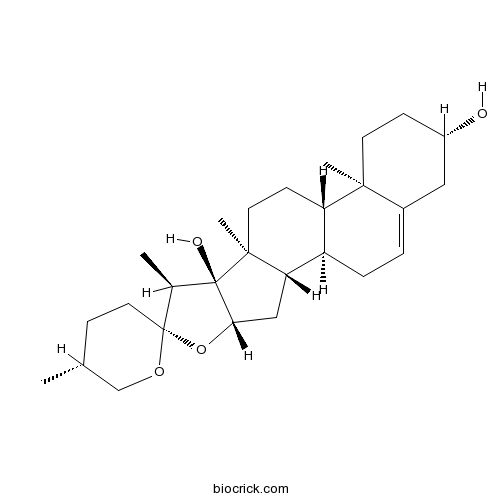PennogeninCAS# 507-89-1 |

Quality Control & MSDS
3D structure
Package In Stock
Number of papers citing our products

| Cas No. | 507-89-1 | SDF | Download SDF |
| PubChem ID | 12314056 | Appearance | Powder |
| Formula | C27H42O4 | M.Wt | 430.62 |
| Type of Compound | Steroids | Storage | Desiccate at -20°C |
| Solubility | Soluble in Chloroform,Dichloromethane,Ethyl Acetate,DMSO,Acetone,etc. | ||
| SMILES | CC1CCC2(C(C3(C(O2)CC4C3(CCC5C4CC=C6C5(CCC(C6)O)C)C)O)C)OC1 | ||
| Standard InChIKey | SYYHBUHOUUETMI-WJOMMTHPSA-N | ||
| Standard InChI | InChI=1S/C27H42O4/c1-16-7-12-26(30-15-16)17(2)27(29)23(31-26)14-22-20-6-5-18-13-19(28)8-10-24(18,3)21(20)9-11-25(22,27)4/h5,16-17,19-23,28-29H,6-15H2,1-4H3/t16-,17-,19+,20-,21+,22+,23+,24+,25+,26-,27-/m1/s1 | ||
| General tips | For obtaining a higher solubility , please warm the tube at 37 ℃ and shake it in the ultrasonic bath for a while.Stock solution can be stored below -20℃ for several months. We recommend that you prepare and use the solution on the same day. However, if the test schedule requires, the stock solutions can be prepared in advance, and the stock solution must be sealed and stored below -20℃. In general, the stock solution can be kept for several months. Before use, we recommend that you leave the vial at room temperature for at least an hour before opening it. |
||
| About Packaging | 1. The packaging of the product may be reversed during transportation, cause the high purity compounds to adhere to the neck or cap of the vial.Take the vail out of its packaging and shake gently until the compounds fall to the bottom of the vial. 2. For liquid products, please centrifuge at 500xg to gather the liquid to the bottom of the vial. 3. Try to avoid loss or contamination during the experiment. |
||
| Shipping Condition | Packaging according to customer requirements(5mg, 10mg, 20mg and more). Ship via FedEx, DHL, UPS, EMS or other couriers with RT, or blue ice upon request. | ||
| Description | 1. Pennogenin steroidal saponins could be utilized to develop anticancer medicines. |

Pennogenin Dilution Calculator

Pennogenin Molarity Calculator
| 1 mg | 5 mg | 10 mg | 20 mg | 25 mg | |
| 1 mM | 2.3222 mL | 11.6112 mL | 23.2223 mL | 46.4447 mL | 58.0558 mL |
| 5 mM | 0.4644 mL | 2.3222 mL | 4.6445 mL | 9.2889 mL | 11.6112 mL |
| 10 mM | 0.2322 mL | 1.1611 mL | 2.3222 mL | 4.6445 mL | 5.8056 mL |
| 50 mM | 0.0464 mL | 0.2322 mL | 0.4644 mL | 0.9289 mL | 1.1611 mL |
| 100 mM | 0.0232 mL | 0.1161 mL | 0.2322 mL | 0.4644 mL | 0.5806 mL |
| * Note: If you are in the process of experiment, it's necessary to make the dilution ratios of the samples. The dilution data above is only for reference. Normally, it's can get a better solubility within lower of Concentrations. | |||||

Calcutta University

University of Minnesota

University of Maryland School of Medicine

University of Illinois at Chicago

The Ohio State University

University of Zurich

Harvard University

Colorado State University

Auburn University

Yale University

Worcester Polytechnic Institute

Washington State University

Stanford University

University of Leipzig

Universidade da Beira Interior

The Institute of Cancer Research

Heidelberg University

University of Amsterdam

University of Auckland

TsingHua University

The University of Michigan

Miami University

DRURY University

Jilin University

Fudan University

Wuhan University

Sun Yat-sen University

Universite de Paris

Deemed University

Auckland University

The University of Tokyo

Korea University
- Borneol
Catalog No.:BCN4964
CAS No.:507-70-0
- Boc-Cys(Bzl)-OH
Catalog No.:BCC3376
CAS No.:5068-28-0
- Terfenadine
Catalog No.:BCC3866
CAS No.:50679-08-8
- Chasmanine
Catalog No.:BCN5409
CAS No.:5066-78-4
- Vandrikidine
Catalog No.:BCN5615
CAS No.:50656-92-3
- Alkaloid C
Catalog No.:BCN1897
CAS No.:50656-88-7
- Alkaloid KD1
Catalog No.:BCN1898
CAS No.:50656-87-6
- Niranthin
Catalog No.:BCN5614
CAS No.:50656-77-4
- Octacosanoic Acid
Catalog No.:BCN5395
CAS No.:506-48-9
- Nervonic acid
Catalog No.:BCN8374
CAS No.:506-37-6
- Arachidonic acid
Catalog No.:BCN2215
CAS No.:506-32-1
- Isojacareubin
Catalog No.:BCN6883
CAS No.:50597-93-8
- Vecuronium Bromide
Catalog No.:BCC2498
CAS No.:50700-72-6
- 3-Cyano-6-isopropylchromone
Catalog No.:BCC8627
CAS No.:50743-32-3
- TPCA-1
Catalog No.:BCC2473
CAS No.:507475-17-4
- Polyphyllin D
Catalog No.:BCN2401
CAS No.:50773-41-6
- Polyphyllin B
Catalog No.:BCN2833
CAS No.:50773-42-7
- Soyasapogenol A
Catalog No.:BCN1433
CAS No.:508-01-0
- Oleanolic acid
Catalog No.:BCN5616
CAS No.:508-02-1
- 13(18)-Oleanen-3-ol
Catalog No.:BCN5617
CAS No.:508-04-3
- Glutinone
Catalog No.:BCN5618
CAS No.:508-09-8
- N-acetylanonaine
Catalog No.:BCN2666
CAS No.:5894-74-6
- Ouabagenin
Catalog No.:BCC8227
CAS No.:508-52-1
- Rosenonolactone
Catalog No.:BCN5621
CAS No.:508-71-4
In-vitro Antitumor Activity and Antifungal Activity of Pennogenin Steroidal Saponins from paris Polyphylla var. yunnanensis.[Pubmed:24250355]
Iran J Pharm Res. 2011 Spring;10(2):279-86.
Paris polyphylla Smith var. yunnanensis, has been used in traditional Chinese medicine for its antibiotic and anti-inflammatory properties; in addition it has been used to cure liver cancer in particular. In this current study, beta-ecdysterone (1) and three Pennogenin steroidal saponins (2-4) were isolated from the EtOH extract of Paris polyphylla var. yunnanensis, and then tested for their antitumor and antifungal activities. Spectroscopic data was used to confirm their structures. Their antitumor properties were determined by using an MTT assay in addition to ethidium bromide and acridine orange staining techniques. Compounds 2, 3 and 4 exhibited significant anti-proliferation activities against HepG2 cells, with IC50 values of 13.5 muM, 9.7 muM and 11.6 muM respectively, obtained following 48 h treatment. Furthermore, we found these Pennogenin steroidal saponins could induce HepG2 cells apoptosis at a concentration of 20 muM after 48 h treatment. Compounds 2, 3 and 4 were confirmed to exhibit moderate antifungal activity. The minimum inhibitory concentration (MIC) of compounds 2, 3 and 4 against saccharomyces cerevisiae hansen were 2.5 mg.mL(-1), 0.6 mg.mL(-1) and 0.6 mg.mL(-1), respectively. The MIC of compounds 2, 3 and 4 against Candida albicans were 1.2 mgmL(-1), 0.6 mg.mL(-1) and 1.2 mg.mL(-1), respectively. The analysis of the bioactivity-structure relationship shows that the sugar moiety plays a critical role in the activity of steroid moiety. Our results suggest that these three Pennogenin steroidal saponins could be utilized to develop anticancer medicines.


